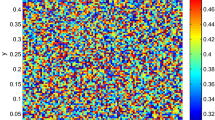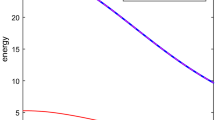Abstract
In this paper, we review some numerical methods presented in the literature in the last years to approximate the Cahn–Hilliard equation. Our aim is to compare the main properties of each one of the approaches to try to determine which one we should choose depending on which are the crucial aspects when we approximate the equations. Among the properties that we consider desirable to control are the time accuracy order, energy-stability, unique solvability and the linearity or nonlinearity of the resulting systems. In particular, we concern about the iterative methods used to approximate the nonlinear schemes and the constraints that may arise on the physical and computational parameters. Furthermore, we present the connections of the Cahn–Hilliard equation with other physically motivated systems (not only phase field models) and we state how the ideas of efficient numerical schemes in one topic could be extended to other frameworks in a natural way.
Similar content being viewed by others
References
Abels H. Diffuse interface models for two-phase flows of viscous incompressible fluids, habilitation thesis. http://www.mathematik.uni-r.de/abels/PrivateHomepage.html
Abels H (2012) Strong well-posedness of a diffuse interface model for a viscous, quasi-incompressible two-phase flow. SIAM J Math Anal 44:316–340
Abels H, Depner D, Garcke H (2013) Existence of weak solutions for a diffuse interface model for two-phase flows of incompressible fluids with different densities. J Math Fluid Mech 15:453–480
Abels H, Garcke H, Grun G (2012) Thermodynamically consistent, frame indifferent diffuse interface models for incompressible two-phase flows with different densities. Math Models Methods Appl Sci 22(03):1150013
Allen S, Cahn JW (1979) A microscopic theory for antiphase boundary motion and its application to antiphase domain coarsening. Acta Metall 27:1084–1095
Badia S, Guillén-González F, Gutiérrez-Santacreu JV (2011) Finite element approximation of nematic liquid crystal flows using a saddle-point structure. J Comput Phys 230:1686–1706
Banas L, Nürnberg R (2008) Adaptive finite element methods for Cahn–Hilliard equations. J Comput Appl Math 218:2–11
Barrett JW, Blowey JF, Garcke H (1999) Finite element approximation of the Cahn–Hilliard equation with degenerate mobility. SIAM J Numer Anal 37:286–318
Bates PW, Fife PC (1993) The dynamics of nucleation for the Cahn–Hilliard equation. SIAM J Appl Math 53:990–1008
Becker R, Feng X, Prohl A (2008) Finite element approximations of the Ericksen–Leslie model for nematic liquid crystal flow. SIAM J Numer Anal 46:1704–1731
Boyer F (2002) A theoretical and numerical model for the study of incompressible mixture flows. Comput Fluids 31:41–68
Boyer F, Minjeaud S (2011) Numerical schemes for a three component Cahn–Hilliard model. ESAIM: Math Model Numer Anal 45:697–738
Cahn JW, Hilliard JE (1958) Free energy of a non-uniform system. I. Interfacial free energy. J Chem Phys 28:258–267
Ceniceros HD (2009) Tracking fluid interfaces approaching singular events. Bol Soc Esp Mat Apl 48:31–57
Copetti MIM, Elliott CM (1992) Numerical analysis of the Cahn–Hilliard equation with a logarithmic free energy. Numer Math 63:39–65
Du Q, Li M, Liu C (2007) Analysis of a phase field navier-stokes vesicle-fluid interaction model. Discret Contin Dyn Syst 8:539–556
Du Q, Liu C, Ryham R, Wang X (2009) Energetic variational approaches in modeling vesicle and fluid interactions. Phys D 238:923–930
Du Q, Liu C, Wang X (2004) A phase field approach in the numerical study of the elastic bending energy for vesicle membranes. J Comput Phys 198:450–468
Du Q, Liu C, Wang X (2006) Simulating the deformation of vesicle membranes under elastic bending energy in three dimensions. J Comput Phys 212:757–777
Du Q, Nicolaides RA (1991) Numerical analysis of a continuum model of phase transition. SIAM J Numer Anal 28:1310–1322
Du Q, Wang X (2007) Convergence of numerical approximations to a phase field bending elasticity model of membrane deformations. Int J Numer Anal Model 4:441–459
Du Q, Zhang J (2008) Adaptive finite element method for a phase field bending elasticity model of vesicle membrane deformations. SIAM J Sci Comput 30:1634–1657
Du Q, Zhu L (2006) Analysis of a mixed finite element method for a phase field bending elasticity model of vesicle membrane deformation. J Comput Math 24:265–280
Elliott CM, French DA (1989) A nonconforming finite-element method for the two-dimensional Cahn–Hilliard equation. SIAM J Numer Anal 26:884–903
Elliott CM, French DA (1987) Numerical studies of the Cahn–Hilliard equation for phase separation. IMA J Appl Math 38:97–128
Elliott CM, French DA, Milner FA (1989) A second order splitting method for the Cahn–Hilliard equation. Numer Math 54:575–590
Elliott CM, Garcke H (1996) On the Cahn–Hilliard equation with degenerate mobility. SIAM J Math Anal 27:404–423
Elliott CM, Songmu Z (1986) On the Cahn–Hilliard equation. Arch Ration Mech Anal 96:339–357
Eyre JD, An unconditionally stable one-step scheme for gradient system, unpublished, www.math.utah.edu/~eyre/research/methods/stable.ps
Feng X (2006) Fully discrete finite element approximations of the Navier–Stokes–Cahn-Hilliard diffuse interface model for two-phase fluid flows. SIAM J Numer Anal 44:1049–1072
Feng X, Prohl A (2004) Error analysis of a mixed finite element method for the Cahn–Hilliard equation. Numer Math 99:47–84
Furihata D (2001) A stable and conservative finite difference scheme for the Cahn–Hilliard equation. Numer Math 87:675–699
Girault V, Raviart PA (1986) Finite element methods for Navier–Stokes equations: theory and algorithms. Springer, Berlin
Gomez H, Calo VM, Bazilevs Y, Hughes TJR (2008) Isogeometric analysis of the Cahn–Hilliard phase-field model. Comput Methods Appl Mech Eng 197:4333–4352
Gomez H, Hughes TJR (2011) Provably unconditionally stable, second-order time-accurate. J Comput Phys 230:5310–5327
Guillén-González F, Gutiérrez-Santacreu JV (2013) A linear mixed finite element scheme for a nematic Ericksen–Leslie liquid crystal model. ESAIM: Math Model Numer Anal 47:1433–1464
Guillén-González F, Tierra G (2013) On linear schemes for a Cahn–Hilliard diffuse interface model. J Comput Phys 234:140–171
Guillén-González F, Tierra G, Second order schemes and time-step adaptivity for Allen–Cahn and Cahn–Hilliard models. Submitted
Guillén-González F, Tierra G, Splitting schemes for a Navier–Stokes–Cahn–Hilliard model for two fluids with different densities. Submitted
Gurtin D, Polignone D, Viñals J (1996) Two-phase binary fluids and immiscible fluids described by an order parameter. Math Models Methods Appl Sci 6:815–831
Hohenberg PP, Halperin BI (1977) Theory of dynamic critical phenomena. Rev Mod Phys 49:435–479
Hu Z, Wise SM, Wang C, Lowengrub JS (2009) Stable and efficient finite-difference nonlinear-multigrid schemes for the phase field crystal equation. J Comput Phys 228:5323–5339
Hua J, Lin P, Liu C, Wang Q (2011) Energy law preserving \(C0\) finite element schemes for phase field models in two-phase flow computations. J Comput Phys 230:7115–7131
Hyon Y, Kwak DY, Liu C (2010) Energetic variational approach in complex fluids: maximum dissipation principle. Discret Contin Dyn Syst 26:1291–1304
Kay D, Styles V, Suli E (2009) Discontinuous Galerkin finite element approximation of the Cahn–Hilliard Equation with convection. SIAM J Numer Anal 47:2660–2685
Kim J (2007) Phase field computations for ternary fluid flows. Comput Methods Appl Mech Eng 196:45–48
Kim J (2012) Phase-field models for multi-component fluid flows. Commun Comput Phys 196:613–661
Kim J, Kang K, Lowengrub J (2004) Conservative multigrid methods for Cahn–Hilliard fluids. J Comput Phys 193:511–543
Kim J, Kang K, Lowengrub J (2004) Conservative multigrid methods for ternary Cahn–Hilliard systems. Commun Math Sci 2:53–77
Kim J, Lowengrub J (2005) Phase field modeling and simulation of three-phase flows. Interfaces Free Boundaries 7:435–466
Lin FH (1989) Nonlinear theory of defects in nematic liquid crystals: phase transition and flow phenomena. Commun Pure Appl Math 42:789–814
Lin FH, Liu C (1995) Non-parabolic dissipative systems modelling the flow of liquid crystals. Commun Pure Appl Math 4:501–537
Lin FH, Liu C (2000) Existence of solutions for the Ericksen–Leslie system. Arch Ration Mech Anal 154:135–156
Lin P, Liu C (2006) Simulations of singularity dynamics in liquid crystal flows: a \(C^0\) finite element approach. J Comput Phys 215:1411–1427
Lin P, Liu C, Zhang H (2007) An energy law preserving \(C^0\) finite element scheme for simulating the kinematic effects in liquid crystal dynamics. J Comput Phys 227:1411–1427
Lowengrub J, Truskinovsky L (1998) Quasi-incompressible Cahn–Hilliard fluids and topological transitions. R Soc Lond Proc Ser A Math Phys Eng Sci 454:2617–2654
Mello EVL, Filho OTS (2005) Numerical study of the Cahn–Hilliard equation in one, two and three dimensions. Phys A 347:429–443
Minjeaud S (2013) An unconditionally stable uncoupled scheme for a triphasic Cahn–Hilliard/Navier–Stokes model. Numer Methods Partial Differ Eq 29:584–618
Novick-Cohen A, Segel LA (1984) Nonlinear aspects of the Cahn–Hilliard equation. Phys D 10:277–298
Shen J, Wang C, Wang X, Wise S (2012) Second-order convex splitting schemes for gradient flows with Enhrich–Schwoebel type energy: application to thin film epitaxy. SIAM J Numer Anal 50:105–125
Shen J, Yang X (2010) A phase-field model and its numerical approximation for two-phase incompressible flows with different densities and viscosities. SIAM J Sci Comput 32:1159–1179
Shen J, Yang X (2010) Numerical approximations of Allen–Cahn and Cahn–Hilliard equations. Discret Contin Dyn Syst 28:1669–1691
van der Waals JD (1893) The thermodynamic theory of capillarity flow under the hypothesis of a continuous variation of density. Verhandel. Konink. Akad. Weten. Amsterdam, 1
Wise SM (2010) Unconditionally stable finite difference, nonlinear multigrid simulation of the Cahn–Hilliard–Hele–Shaw system of equations. J Sci Comput 44:1
Wodo O, Ganapathysubramanian B (2011) Computationally efficient solution to the Cahn–Hilliard equation: adaptive implicit time schemes, mesh sensitivity analysis and the 3D isoperimetric problem. J Comput Phys 230:6037–6060
Wu X, van Zwieten GJ, van der Zee KG (2013) Stabilized second-order convex splitting schemes for Cahn–Hilliard models with application to diffuse-interface tumor-growth models. Int J Numer Methods Biomed Eng, 30:180–203
Yue P, Feng JJ, Liu C, Shen J (2004) A diffuse-interface method for simulating two-phase flows of complex fluids. J Fluid Mech 515:293–317
Acknowledgments
G. Tierra has been supported by ERC-CZ project LL1202 (Ministry of Education, Youth and Sports of the Czech Republic) while F. Guillén-González has been supported by project MTM2012-32325 (Ministerio de Economía y Competitividad, Spain).
Author information
Authors and Affiliations
Corresponding author
Rights and permissions
About this article
Cite this article
Tierra, G., Guillén-González, F. Numerical Methods for Solving the Cahn–Hilliard Equation and Its Applicability to Related Energy-Based Models. Arch Computat Methods Eng 22, 269–289 (2015). https://doi.org/10.1007/s11831-014-9112-1
Received:
Accepted:
Published:
Issue Date:
DOI: https://doi.org/10.1007/s11831-014-9112-1




